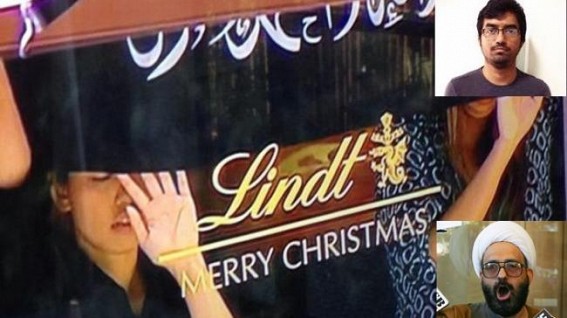Amit Dasgupta Former Diplomat

PHOTO : TIWN
The Sydney café siege is over. While no tears will be shed over the gunman, two families have lost their loved ones. Christmas will not be the same. The incident has left fun-loving Sydney shaken and will trigger introspection and investigation. In a separate incident, techie Mehdi Masroor Biswas was arrested with the assistance of MI6 and the Bengaluru police have started retracing his digital footprint to identify his proximity with the IS network. Are there parallels between the two incidents?
Man Haron Monis, the gunman in the café siege was 50 years old and a self-proclaimed Muslim cleric and prefaced his name with the title Sheikh. He had a history of serious offences and criminal behaviour and first came to the attention of law enforcement agencies when he sent a series of offensive letters to grieving families of Australian soldiers killed in Afghanistan. He was charged and placed on a two-year good behaviour bond. That was in 2013. Within a year, he was charged with being an accessory to his ex-wife’s brutal murder and to over 40 sex offences against women. He was out on bail at the time of the café siege. Following his death, his brother and mother posted on Facebook that he was "a sick animal", that they were happy he was dead and "may he rot in hell".
Mehdi Masroor Biswas, on the other hand, is 24 years old and comes from a poor family. He holds an engineering degree and was working for a MNC at the time of his arrest from his one-room tenement in Bengaluru. Quiet and withdrawn, Biswas was hard-working and excelled in his studies. Following his arrest, his parents expressed shock and dismay, insisting he was innocent and a victim of cyber crime. Biswas, however, openly admitted to links with the Sunni radical group Islamic State (IS).
So, what is similar between them? There are clear indications that both suffered from low self-esteem and craved attention. Mehdi had over 17,000 followers on his twitter account, which registered two million hits a month and was apparently followed by over two-thirds of all foreign fighters on the micro-blogging site. There was no remorse on his part when he was arrested. For him, this was his minute of fame. He was in the news and the centre of attention. He claims that he could have easily joined IS but did not do so as his family was financially dependent on him.
Monis, similarly, asked the hostages to relay his demands through social media and to call up media outlets. His use of the Islamic prayer flag and his demand for an IS banner were clear indications of his desire to be associated with a ‘cause’ and derive attention. His choice of the café, which is adjacent to a leading TV channel, reflects this as was his insistence on speaking with the Australian prime minister and his hoax claim that he had planted four bombs. He felt he had become important by single-handedly shutting down the city's Central Business District and getting the undivided attention of the New South Wales police. Wielding a weapon over innocent and unarmed visitors to the café, Monis felt powerful and energized.
There is no evidence to suggest that either Monis or Biswas were committed jihadists or subscribed to IS. Monis was intellectually vacuous and with serious interpersonal problems. Biswas, on the other hand, was bright and an introvert. They remind you of Maxim Gorky’s "Life of a Useless Man" where the desire for self-esteem, social recognition and the need to feel important can drive human beings to committing the most evil and despicable acts.
In identifying the causes behind terror acts, the horrific role that seeking attention can play needs to be recognized. This only increases the arena. Now, recruitment need no longer be restricted to those who might be prone to being influenced by fundamentalist and jihadist ideology and thus, agree to maim and kill. Recruitment can, in fact, extend to the many who feel socially left out and are desperate to join a club, any club, if it guarantees self-esteem, however misplaced. This is clearly disturbing because it suddenly and hugely expands the canvas that intelligence agencies now need to probe, so that they might thwart terror attacks.
Societies, simultaneously, face another problem. The fact that Monis and Biswas are Muslims can trigger anti-Muslim sentiments. In multicultural Australia, there is fear that the incident could see restrictions on movement and tighter immigration policies that specifically target Muslims. As early as September 2012, the assistant commissioner of counter-terrorism raised concerns about the Lebanese community, who are long-term residents of Australia, by arguing that if the al-Qaeda or a like-minded group took power in Syria, they could find willing recruits among the Lebanese community.
Isolation of the Muslim community could seriously jeopardise the multicultural fabric of Australian society. Similarly, in India, equating Biswas’s actions as Muslim solidarity will irreparably damage India’s plural tapestry.
Monis is dead. Biswas is arrested. The questions begin.
(Amit Dasgupta, a former Indian diplomat, was Consul General in Sydney from February 2009 till June 2012. The views expressed are personal )
- Why Modi’s BJP swept key India regional elections
- TIWN’s landmark legal victory against BJP Govt’s Illegal attacks to shutdown fearless Media
- India to be world's third-largest economy by 2030 -S&P Global Ratings
- Tripura's Dark Era : Mafia style Brutal attacks on Journalists, fight for your Citizen rights !
- How to access tripurainfoway.com via HOLA from India



